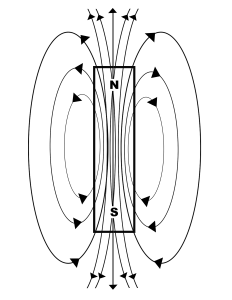EMI-101-5 Part Series - Preface
Preface | Part 1 | Part 2 | Part 3 | Part 4 | Part 5 | Conclusion
Here's a five part series on EMI. The information provided will help you determine which type of EMI you may have and the solutions to fix the interference.
PART 1

Unwanted EMI/RFI signals are generated in two ways when electrons flow through a conductor. They generate both a magnetic field (H-Field) and a radiated electric field (E-Field). Both forms of energy can be disruptive to sensitive electronics to some degree. To understand these unseen forms of energy and how each may impact an electronic system, it is desirable to visualize each type to understand how they might impact other systems around them.
Magnetic Fields (H-Fields) emanating from a linear conductor can be visualized like a bar magnet. In a magnet, one pole is positive and one pole is negative. Magnetic field lines emanate from the positive pole and loop out away from the magnet to the negative pole. The closer the field lines are to the magnet, the closer together they are and in turn the stronger they are. As the distance from the magnet increases, the field lines get further and further apart from one another and the result is that the field strength is weaker as the distance increases. Field strength drops with the square of the distance. The effect of an H-field on the surrounding environment is also a function of the amount of power flowing through the conductor. Power (amperage) flowing through a conductor dictates how far away the H-field extends from the conductor and how strong the field is. The degree of impact an H-field will have on surrounding systems is also a factor of the physical orientation of the two systems. If a low-voltage signal circuit conductor runs parallel and fairly close to the high-power conductor generating a significant H-field, then the signal circuit conductor will be immersed in the intense field lines over a significant distance and the disruption of the signal circuit will be significant. If it were to cross the high-power conductor at 90 degrees, then the field line exposure would be minimized and the impact or disruption would be smaller, or possibly insignificant. The general rule for minimizing known H-field problems is to increase conductor separation distance and avoid parallel runs as much as possible.

Examples of large H-field emitters are conductors running to large motors and relays which demand high current loads. These types of fields generally occur at lower frequency ranges of typically 300 KHz or less.
Electric Fields (E-Fields) are different than H-fields in several ways. They typically extend for great distances from the radiating source, unlike H-fields, and they can impart an electrical charge onto unprotected cabling through electromagnetic induction, electrostatic coupling, or conduction.

Linear cable runs are essentially antennas that can transmit and receive signals. Cables are highly susceptible to picking up unwanted stray signals moving through the environment. E-field noise can be visualized as a wave, not unlike those created when dropping a pebble into a pond. The wave radiates away from the generating source in all directions and dissipates its energy very slowly. The distance that the wave travels before dissipating is a function of the power level that the radiating system is generating. The wavelength of an electric field varies with frequency range. At low frequencies the wavelengths are quite long and as the frequency range increases the wavelengths get shorter and shorter. Low-frequency wavelengths may be a kilometer long where as high-frequency wavelengths may be less than a centimeter long.

Linear cable runs are essentially antennas that can transmit and receive signals. Cables are highly susceptible to picking up unwanted stray signals moving through the environment. E-field noise can be visualized as a wave, not unlike those created when dropping a pebble into a pond. The wave radiates away from the generating source in all directions and dissipates its energy very slowly. The distance that the wave travels before dissipating is a function of the power level that the radiating system is generating. The wavelength of an electric field varies with frequency range. At low frequencies the wavelengths are quite long and as the frequency range increases the wavelengths get shorter and shorter. Low-frequency wavelengths may be a kilometer long where as high-frequency wavelengths may be less than a centimeter long.


















